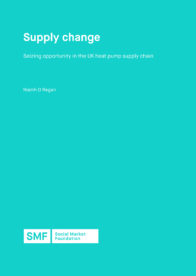Despite the government’s target to reach net zero emissions by 2050, the UK’s heat pump supply chain is still in its infancy and remains much weaker than in mainland Europe or Asia. This report explores the economic and environmental benefits of making the UK’s heat pump supply chain more robust and provides recommendations for how to turn this opportunity into a reality.
SUMMARY
- The pandemic and the war in Ukraine have highlighted the vulnerability of the global heat pump supply chain, leaving the UK, where heat pumps are typically imported, in a difficult position. The UK should capitalise on the increased demand for heat pumps, as developed countries recognise the need to move away from gas-based home heating, by strengthening its supply chain.
- The government’s ambition to reach 600,000 heat pump installations a year by 2028 means domestic demand for heat pumps is set to grow, presenting manufacturers with a market opportunity. Domestic manufacturing could contribute £5.5 billion to the UK economy, spur job creation and innovation in heat pump design, as well as reduce the risk of supply chain shocks.
- Improvements in installation are key to reducing the cost of heat pumps. This requires more skilled installers and new entrants to the industry, and would provide green jobs both in installation and system design. New offers to consumers, such as whole home energy packages or property-linked financing, can also help make heat pump installation more affordable.
- To capitalise on the opportunity that heat pumps present, the government should:
- Provide certainty on the future of heat pumps to persuade manufacturers to invest, such as by naming heat pumps in the Future Homes Standard and adopting a long-term funding approach.
- Consciously develop the heat pump installation workforce by working with industry and training providers to design a strategy for scaling it up.
Maximise the potential for opportunities to succeed by restructuring energy pricing to make heating through electricity more financially viable and supporting the creation of innovative financial products.

DOWNLOAD THE REPORT: PDF
Kindly sponsored by

